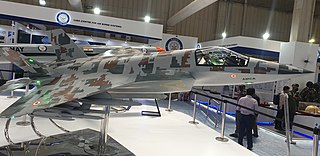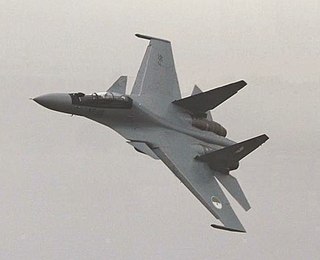
The Saab 37 Viggen is a single-seat, single-engine multirole combat aircraft designed and produced by the Swedish aircraft manufacturer Saab. It was the first canard-equipped aircraft to be produced in quantity.

Hindustan Aeronautics Limited (HAL) is an Indian public sector aerospace and defence company, headquartered in Bangalore. Established on 23 December 1940, HAL is one of the oldest and largest aerospace and defence manufacturers in the world. HAL began aircraft manufacturing as early as 1942 with licensed production of Harlow PC-5, Curtiss P-36 Hawk and Vultee A-31 Vengeance for the Indian Air Force. HAL currently has 11 dedicated Research and development (R&D) centres and 21 manufacturing divisions under 4 production units spread across India. HAL is managed by a board of directors appointed by the President of India through the Ministry of Defence, Government of India. HAL is currently involved in designing and manufacturing of fighter jets, helicopters, jet engine and marine gas turbine engine, avionics, software development, spares supply, overhauling and upgrading of Indian military aircraft.

The fourth-generation fighter is a class of jet fighters in service from around 1980 to the present, and represents design concepts of the 1970s. Fourth-generation designs are heavily influenced by lessons learned from the previous generation of combat aircraft. Third-generation fighters were often designed primarily as interceptors, being built around speed and air-to-air missiles. While exceptionally fast in a straight line, many third-generation fighters severely lacked in maneuverability, as doctrine held that traditional dogfighting would be impossible at supersonic speeds. In practice, air-to-air missiles of the time, despite being responsible for the vast majority of air-to-air victories, were relatively unreliable, and combat would quickly become subsonic and close-range. This would leave third-generation fighters vulnerable and ill-equipped, renewing an interest in manoeuvrability for the fourth generation of fighters. Meanwhile, the growing costs of military aircraft in general and the demonstrated success of aircraft such as the McDonnell Douglas F-4 Phantom II gave rise to the popularity of multirole combat aircraft in parallel with the advances marking the so-called fourth generation.

The Nanchang Q-5, also known as the A-5 in its export versions, is a 1960s-design Chinese-built single-seat, twin jet engine ground-attack aircraft based on the Shenyang J-6. The aircraft is primarily used for close air support.

The Hongdu JL-8, also known as the Karakorum-8 or K-8 for short, is a two-seat intermediate jet trainer and light attack aircraft designed in the People's Republic of China by China Nanchang Aircraft Manufacturing Corporation. The primary contractor is the Hongdu Aviation Industry Corporation.

The HAL Tejas is an Indian single engine, delta wing, light multirole fighter designed by the Aeronautical Development Agency (ADA) in collaboration with Aircraft Research and Design Centre (ARDC) of Hindustan Aeronautics Limited (HAL) for the Indian Air Force and Indian Navy. It was developed from the Light Combat Aircraft (LCA) programme, which began in the 1980s to replace India's ageing MiG-21 fighters but later became part of a general fleet modernisation programme. In 2003, the LCA was officially named "Tejas". It is the smallest and lightest in its class of contemporary supersonic combat aircraft.

The Yakovlev Yak-141, also known as the Yak-41, is a Soviet supersonic vertical takeoff/landing (VTOL) fighter aircraft designed by Yakovlev. Intended as a replacement for the Yak-38, it was designed as a supersonic fleet defence fighter capable of STOVL/VTOL operating from Soviet carriers. Four prototypes were built before the project's cancellation.

The HAL HJT-36 Sitara is a subsonic intermediate jet trainer aircraft designed and developed by Aircraft Research and Design Centre (ARDC) and built by Hindustan Aeronautics Limited (HAL) for the Indian Air Force and the Indian Navy. The HJT-36 will replace the HAL HJT-16 Kiran as the Stage-2 trainer for the two forces.

The Aero L-59 Super Albatros is a military jet trainer produced by the Czechoslovakian aerospace manufacturer Aero Vodochody. It was developed from the firm's earlier and highly successful L-39 Albatros series.

The IAR 99Șoim (Hawk) is an advanced trainer and light attack aircraft capable of performing close air support and reconnaissance missions. The IAR 99 replaced the Aero L-29 Delfin and Aero L-39 Albatros as the jet trainer of the Romanian Air Force. The aircraft is of semi-monocoque design, with tapered wings and a swept-back tail unit. A large blade-type antenna installed beneath the nose on the port side of the fuselage gives the IAR 99 trainer a distinctive appearance.

The HAL Advanced Medium Combat Aircraft (AMCA) is an Indian programme to develop a fifth-generation stealth, multirole combat aircraft for the Indian Air Force and the Indian Navy which will also include sixth-generation technologies. The design of the aircraft is carried out by Aeronautical Development Agency (ADA) of Defence Research and Development Organisation (DRDO). It is expected to be produced by a public-private joint venture between the DRDO, Hindustan Aeronautics Limited (HAL), and an Indian private company. The development cost is estimated to be around ₹15,000 crore.

The Sukhoi Su-30MKI is a two-seater, twinjet multirole air superiority fighter developed by Russian aircraft manufacturer Sukhoi and built under licence by India's Hindustan Aeronautics Limited (HAL) for the Indian Air Force (IAF). A variant of the Sukhoi Su-30, it is a heavy, all-weather, long-range fighter.

The Aermacchi M-345 is a turbofan-powered military trainer aircraft designed and produced by the Italian defense conglomerate Leonardo S.p.A.

The ALR Piranha was an aircraft project undertaken by the Swiss Air Force's Swiss Working Group for Aerospace (ALR) to develop a lightweight multi-role combat aircraft with canard wings. The ALR is the Aerospace Project Development Group of the Swiss Air Force. The project was managed by Bridel, an engineer at the ETH Zurich.

The NPO Saturn AL-55 is a high performance turbofan engine manufactured by NPO Saturn Russia, for powering advanced trainers, unmanned aerial vehicles (UAV) and light attack aircraft. A variant of the AL-55I powers the HAL HJT-36 Sitara Indian jet trainer.

The British Aerospace Hawk 200 is a single-seat, single engine light multirole fighter designed for air defence, air denial, anti-shipping, interdiction, close air support, and ground attack.

The HAL Tejas Mark 2, or Medium Weight Fighter (MWF), is an Indian single-engine, canard delta wing, multirole combat aircraft designed by the Aeronautical Development Agency (ADA) in collaboration with Aircraft Research and Design Centre (ARDC) of Hindustan Aeronautics Limited (HAL) for the Indian Air Force (IAF). It is a further development of the HAL Tejas, with an elongated airframe, close coupled canards, new sensors, and a more powerful engine.

The Sukhoi Su-30MKA is a twinjet multirole air superiority fighter developed by Russia's Sukhoi made for the Algerian Air Force. A variant of the Sukhoi Su-27S, it is a heavy, all-weather, long-range fighter. The aircraft is based on the Indian Sukhoi Su-30MKI III and is the 2nd adaptation of the same, after the first one being the Malaysian Sukhoi Su-30MKM.

The HAL HLFT-42 is an Indian Lead-in fighter trainer currently under development by Hindustan Aeronautics Limited. Designed as a next-generation supersonic trainer jet, serving as an advanced trainer for upcoming HAL Tejas Mk2 and HAL AMCA Fighter jets. Notably, The HLFT-42 will also be used as a fully-fledged fighter jet to perform combat missions. HAL unveiled the design of the scale model of the HLFT-42 at the 14th edition of Aero India (2023), which was held in Bangalore.


















